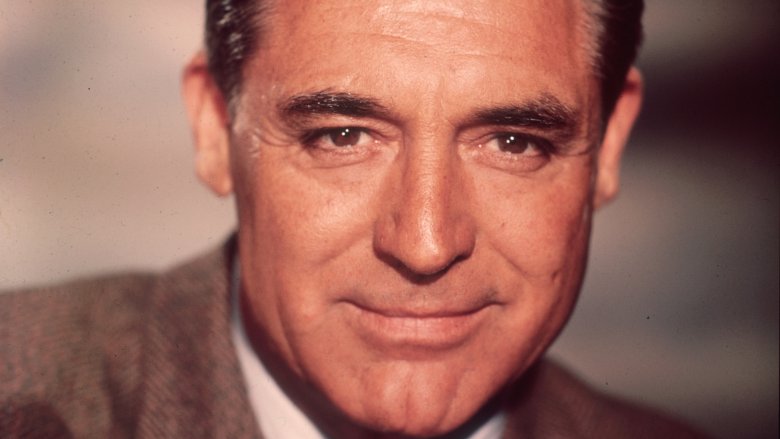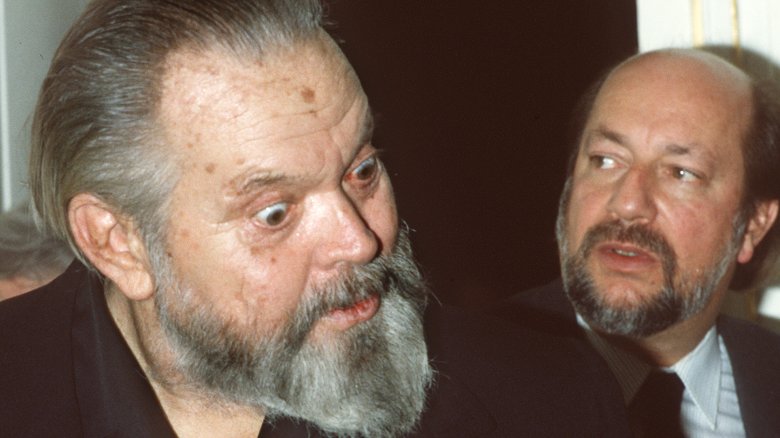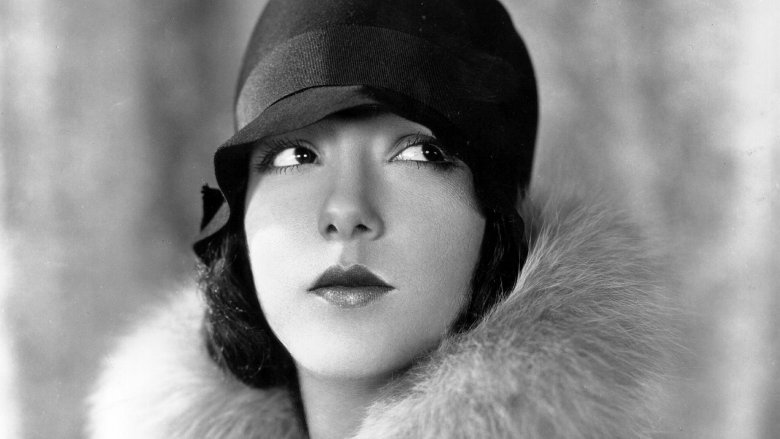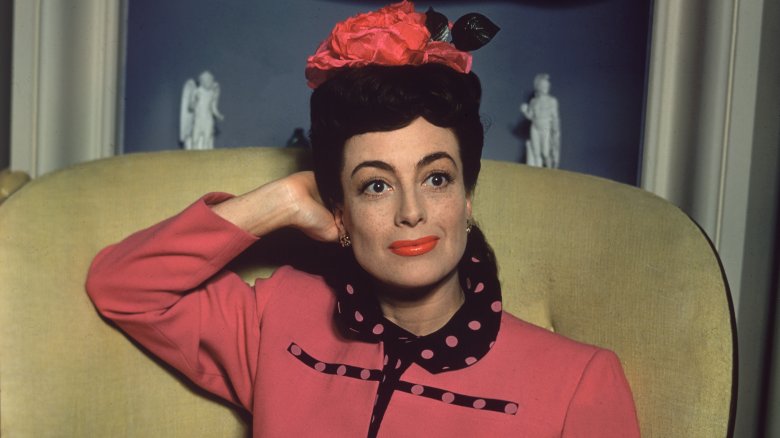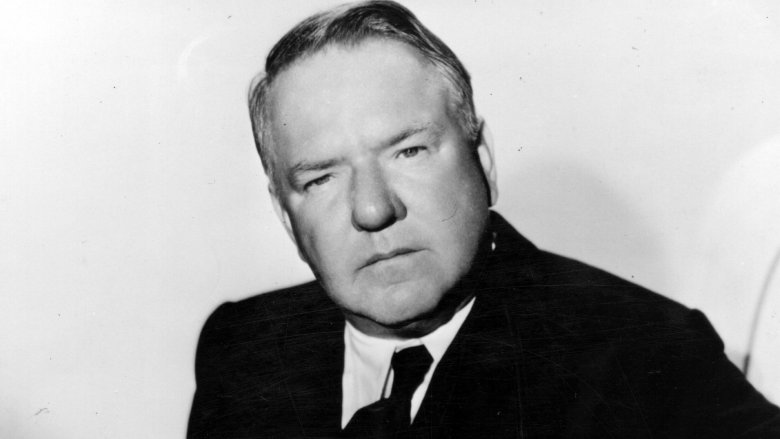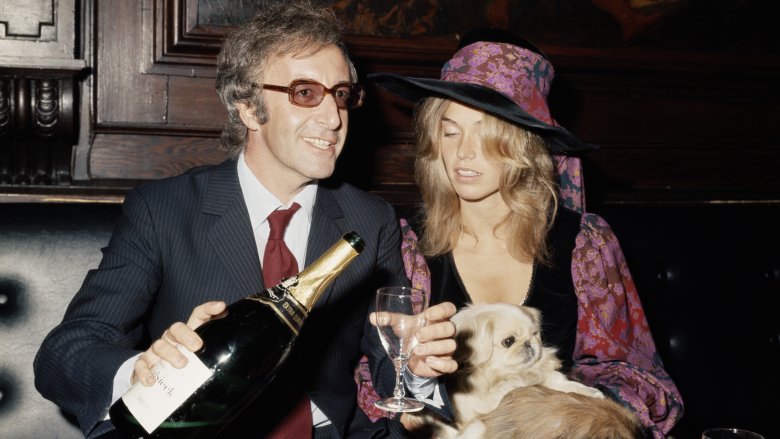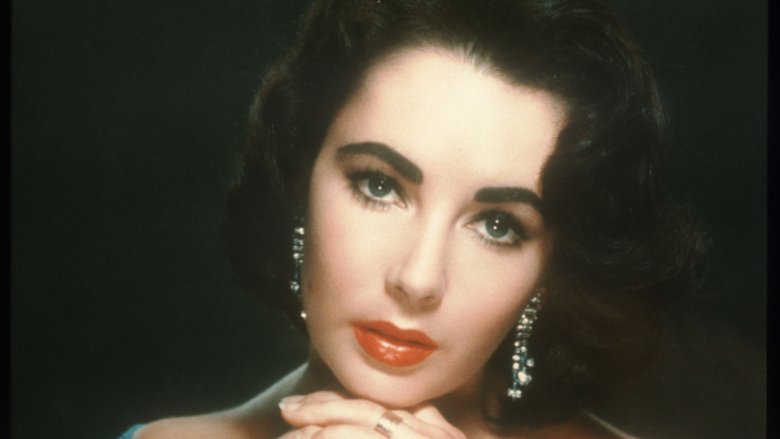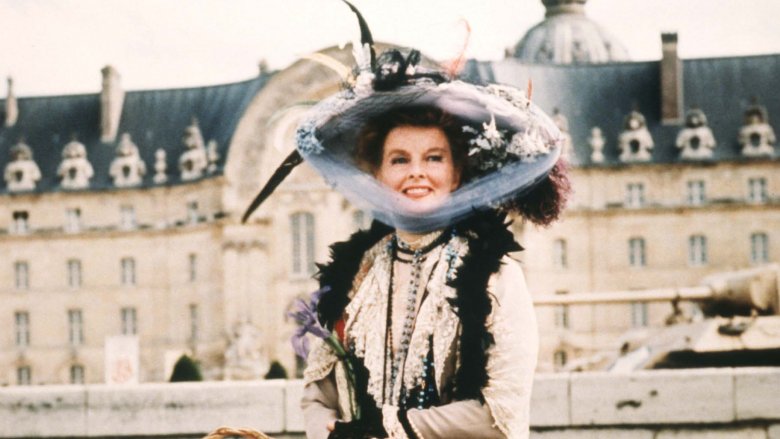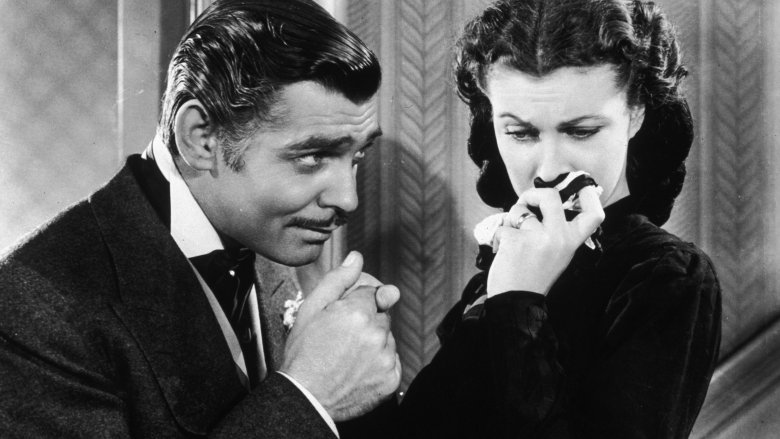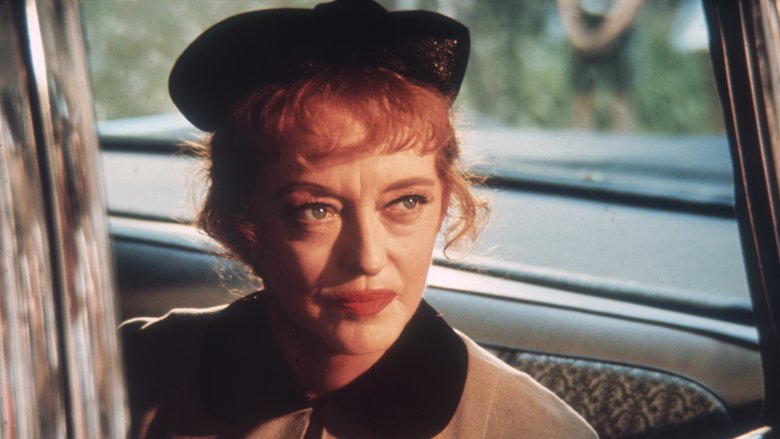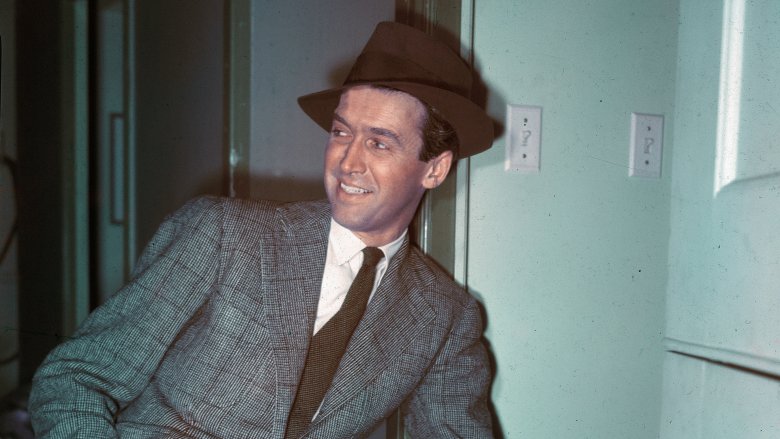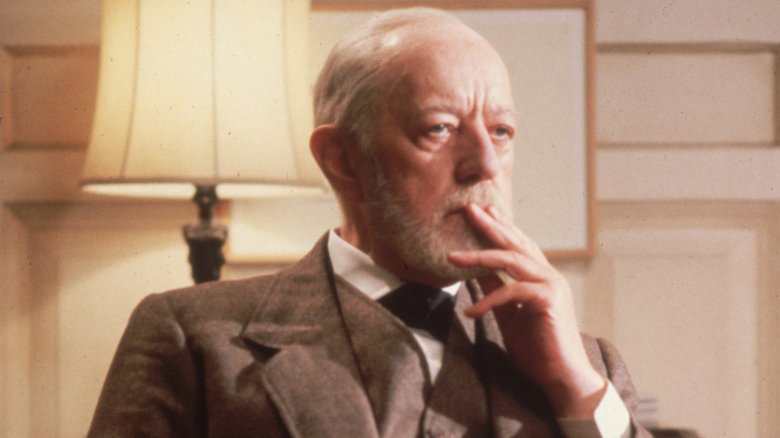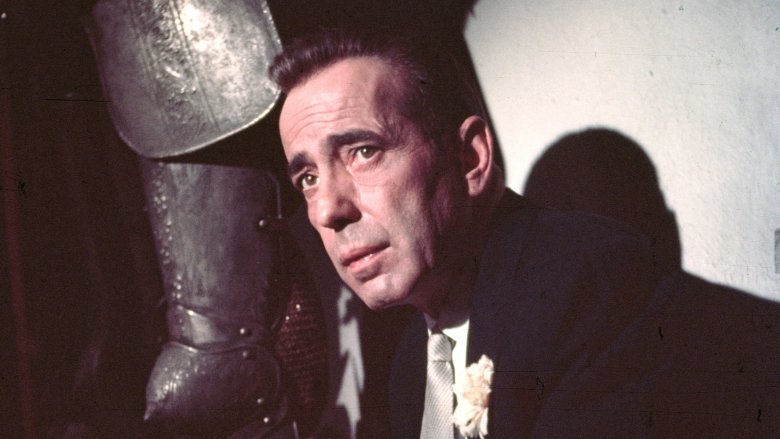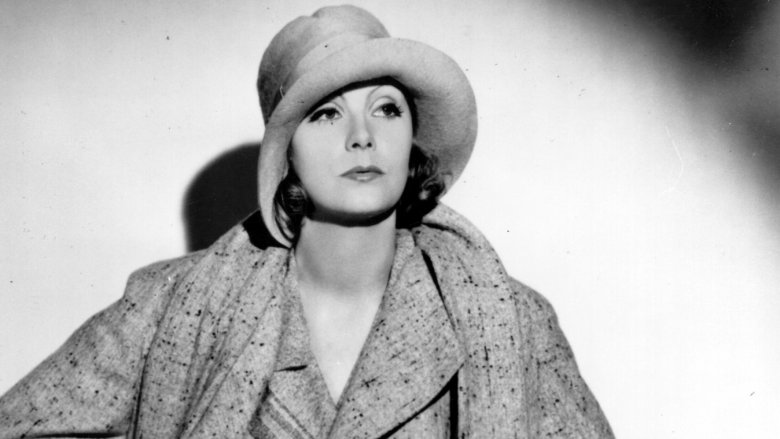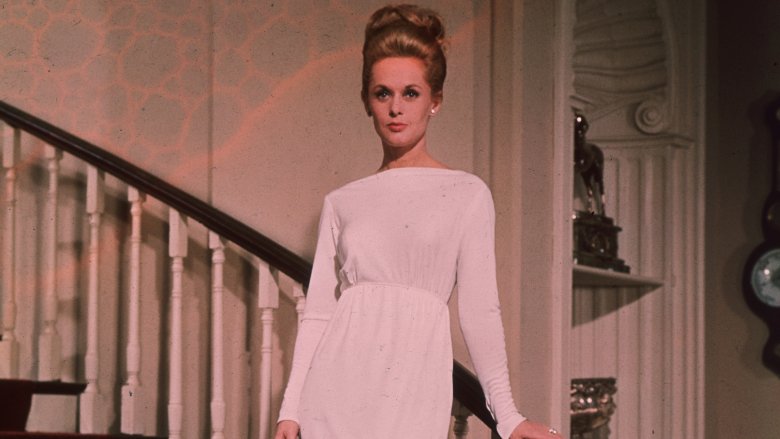Classic Film Stars Who Were Actually Really Eccentric People
"Old Hollywood" is a synonym for class, sophistication, and images of matinee idols chastely stealing kisses on the silver screen. That's sure not how it felt at the time. Behind the glitz and glamour, Golden Age Tinseltown had a darker, more eccentric side. Even classic film stars had vices, addictions, and obsessions.
Cary Grant was an evangelical LSD fanatic
In 1960, the editors at Good Housekeeping magazine got a strange call. Cary Grant, the suave, sophisticated film star who almost never gave interviews, was on the line and wanted to talk. The trouble was, the only thing he wanted to talk about was the magnificent amount of LSD he'd dropped. That, and the fact he now wanted everyone else to start dropping acid, too (via The Guardian).
Born into a super-poor family in Bristol, with a cheating father and a mother who straight-up vanished (it later turned out the cheating father had needlessly had her committed to an insane asylum), Grant spent most of his acting life dealing with his hidden demons. After decades of torment, he was finally turned onto LSD therapy by his third wife. What happened in those sessions evidently blew his mind. From 1958 to 1961, Grant dropped acid a minimum of 100 times. But rather than make the inside of his head resemble the plot of Yellow Submarine, it turned him into an evangelical for his pick-me-up.
This is acid we're talking about, so the things Grant was evangelizing about sounded screwy at best. One vision Grant fondly recalled involved him turning into a gigantic wang and blasting off into space. It was only when the counterculture went acid crazy that Grant stopped dosing, lest his gentlemanly image clash with all those darn hippies burning bras and dropping out.
Peter Lorre was whacked out on morphine the entire time
If you've ever seen a picture of Peter Lorre, you've probably noticed his eyes: all droopy, like he's about to fall asleep. Lorre leveraged his weird looks into a long career playing oddballs and villains. But his distinctive expression may have had less to do with genetics and more to do with what the Casablanca actor was sticking in his arm. Lorre spent his entire career whacked out on morphine.
His addiction started long before he ever graced a Hollywood screen, following an appendix operation in his native Europe. According to the London Review of Books, his doctors kept the young actor so full of morphine that he wound up hopelessly addicted. By the time he appeared as the serial killer in Fritz Lang's disturbing German thriller M, Lorre's addiction was so well-known in acting circles that his friends joked the "M" stood for "morphine" (via the Independent). He carried the addiction over with him when he transitioned to Hollywood, where he also got hooked on prescription pills and cough medicine.
For stretches of his career, Lorre was even choosing roles based on how they interfered with his drug taking. He took the part of Mr. Moto in an eight-film series because he needed drug money, but also because they'd let him shoot up in his trailer. Whole films were shot with him so smacked out he could barely climb the stairs. And he still out-acted everybody else on set.
Orson Welles was obsessed with making his nose bigger
The idea of the nose job caught on because there are a huge amount of people in the world who all fixate on the idea of making their nose smaller. Not Orson Welles. The actor/director/writer/producer/show-off thought his nose was way too small for his rotund face. So he did what anyone with a studio makeup department at his beck and call would do. He had a whole slew of fake noses created for each role he played, the bigger the better.
Film blog Movie Morlocks has the details, and they're as bizarre as one of Welles' fake schnozzes. In nearly every movie appearance he made, Welles sported a fake nose. At the start of his career, these were relatively normal sizes. By the end, they were misshapen, bulging things that swelled out the center of his face like a lost alien chestburster making a dash for the nearest exit. And you better believe he was unwilling to work without them. When he took an acting gig on Black Magic, while still trying to finish directing Macbeth, the star was more worried about his box of misplaced noses than he was about his unfinished picture.
When he finished a film, Welles kept his noses, named them, and stored them in his Hollywood home, where he would occasionally take them out at parties and perform magic tricks with them. That's the sort of crazy you can get away with when you've directed the best film ever made.
Lupe Velez was obsessed with death (and Gary Cooper)
Lupe Velez was known as "the Mexican spitfire." A more accurate portrayal might be as the girl who gave so few damns she made Rhett Butler look like he could use his collection to dam the Colorado. In an essay, MIT professor Henry Jenkins once recounted all of her outbursts, which ranged from staging fights in public, to attending wrestling matches and screaming for blood, to unzipping Gary Cooper's fly at a social gathering and sniffing his crotch in an effort to detect whether he'd been seeing a man.
That last sentence highlights another of Velez's obsessions. In her life, Velez tore through men like an out of control combine harvester, but she could never shake her infatuation with Cooper. This may have been due to her assertion that the High Noon star had "the biggest organ in Hollywood," or it may have been due to the fact that Cooper was the only man on Earth who could keep up with her hellraising. Not that the two always got on; on one memorable occasion, an angry Velez stabbed him.
The weirdest part of Velez's life may have been its end. The star committed suicide, but not before putting an insane level of planning into her demise. She adorned her apartment with flowers, lit candles, meticulously did her makeup, selected an outfit, and generally approached death as you would a fashion shoot (via AnOther magazine). But the effort was wasted on the living. No pictures exist of her sendoff.
Joan Crawford was an unhinged egomaniac
Outwardly, Joan Crawford seemed like a woman living the dream. She was a three-time Oscar-nominated actress. She gave to charitable causes, adopting five children into her home. On the wild side, she had a steamy one-night stand with Marilyn Monroe, proving that real life can do better slash fiction than the internet. Inwardly, though, Crawford wasn't as wonderful as she seemed. According to her adopted daughter, Christina, she was an egomaniac who was consumed by jealousy.
The accusations came the year after Crawford died, when Christina published her infamous book Mommie Dearest (via The Guardian). An account of her time as Crawford's ward, it made the Hollywood star sound like the mother from hell. Among other tidbits were the revelation that Crawford had told Christina her birth mother was dead (she wasn't), scenes of Crawford having a meltdown when she discovered her daughter's dresses hung on wire hangers, and harrowing descriptions of the physical abuse Crawford occasionally unleashed on her children.
Christina's book has its detractors. Two of Crawford's other adopted children have disputed its account. Still, it remains plausible, partly because Crawford's madness is so well-documented elsewhere. She went through shady back channels to adopt her kids, resulting in one being reclaimed by his furious birth mother just days after arrival. There's also her bitter rivalry with the equally strange Bette Davis, which culminated in Crawford sabotaging her own film's box office to stop Davis winning her third Oscar (via Vanity Fair).
W.C. Fields was an alcoholic nutcase
W.C. Fields wasn't an actor. That's not a putdown, but a reference to the fact that the misanthropic, alcoholic jerk he played in all his movies wasn't a character. The real-life Fields was just as moody, and — importantly — just as drunk as the screen version.
In a look back at Fields' classic 1940 comedy The Bank Dick, Roger Ebert gave a detailed insight into Fields' alcohol-fueled madness. The overweight, mottled star was more or less continuously drunk for his entire career. He was obsessed by the thought of being caught short without a drop, to the extent that he hoarded enough liquor in his attic to keep him going for 25 years. (One version of the story holds this was an insurance move in case Prohibition returned.) Inevitably, this dedication to chasing the green fairy, plus any other fairies of any color that might conceivably get him drunk, impacted his career. Late in life, Fields would demand $15,000 for each screenplay he wrote. Any producer foolish enough to stump up the cash would get some vague scrawlings on the back of an envelope — if that.
Then there was the way he sometimes liked to just mess with regular folks. According to his old friend Groucho Marx, Fields used to hide behind bushes on his front lawn and shoot at passersby with a BB gun. Remove the financial institution angle from The Bank Dick and you have a pretty accurate description of Fields.
Peter Sellers was terrified of the color purple
The title here doesn't refer to the book The Color Purple, which would be a crazy thing to be terrified of. It refers to the actual color purple, which is somehow an even crazier thing to be terrified of. That didn't stop Peter Sellers. The British actor who gave us Doctor Strangelove was privately perhaps stranger than even that legendary weirdo.
This wasn't a bumbling, goofy strangeness, either. By all accounts, Sellers was such a monumental butthead that few could stand to be around him. He'd have screaming meltdown tantrums on set. He'd freak out at his wives, smash crockery, and threaten them with his shotgun (via Time). He'd get low-level people fired on movies as a way of venting his frustrations against those — directors, producers — who were more powerful than he was. He was vaguely racist and profoundly superstitious. These traits combined when he worked with famed director Vittorio de Sica (Bicycle Thieves) into a conviction that the Italian was a source of supernatural knowledge. All of which brings us to the color purple.
While working on After the Fox, Sellers saw de Sica freak out at a script girl for wearing purple. The director told him it was the color of death, which Sellers took literally. According to the biography Mr. Strangelove, Sellers became convinced the color purple could kill. He refused to be in rooms with it and would have screaming tantrums if he came into contact with it.
Elizabeth Taylor would get engaged out of spite
Elizabeth Taylor's hellraising is so infamous that our mental image of her and Richard Burton hitting the bottle like a couple of W.C. Fieldses can overshadow her actual work. That's probably how it should be. While any cinephile could name a dozen actresses who could play Cleopatra, they'd be hard pressed to name any other actress whose private life was denounced by the Vatican.
Part of that denouncement was the social mores of the time. Part of it was straight-up misogyny. (How many perma-drunk male Casanovas get called out by the Pope?) Part of it was probably deserved. Taylor was as addicted to pleasure as she was to controversy. Over her lifetime, she married eight times, had endless affairs, got drunk at every opportunity, and took great pride in the offense she caused. Sometimes, her behavior was truly outrageous. After marrying and divorcing Richard Burton twice, Taylor was so upset that she got engaged just to spite him.
The Telegraph has the story. When working on Noel Coward's Private Lives, Taylor and Burton brought out the worst in each other. They separately turned up drunk. They broke character. They skipped performances. When Taylor missed a show, Burton got fed up, went to Vegas, and married Sally Hay. When Taylor heard the news, she was so furious she announced her engagement to Victor Luna, upstaging Burton. Not that she ever hated her ex-husband. Later in life, Taylor claimed they would have married a third time if only Burton hadn't died.
Katharine Hepburn hated nudity
The best way to describe Katharine Hepburn is "fiercely independent." The legendary screen goddess was the sort of person who lives life on her own terms with such steel that it's easier to change the entire world than it is to try and bend her to society's pressure. Just look at how admirable her behavior would be today. Hepburn had a fondness for romance with women but a disinclination to move that romance into the bedroom. She lived as if married with both women and men, all while acting like it was no big deal. For a woman to be doing that openly in the mid-20th century took the sort of iron resolve even Iron Man would lack.
Admirable as Hepburn's life was, there was one area where her determination took her down a very strange path indeed. After allegedly trying intercourse just once and hating it, Hepburn became a passionate hater of nudity (via The Telegraph).
This hatred wasn't just confined to the idea of her being personally naked with another naked person, or even to the idea of her encountering nudity in real life. Hepburn was so un-enamored with anything that even faintly whiffed of desire that she'd storm out of movies if a scene came on in which someone was au naturale. One wonders what she made of Elizabeth Taylor's cheerfully debauched private life when the two co-starred in 1959's Suddenly, Last Summer.
Clark Gable was obsessed with cleanliness
"Cleanliness is next to godliness." Whoever wrote those words was clearly lacking two things: access to a dictionary, and any knowledge of the life of Clark Gable. A heavy-drinking party animal, Gable was probably the antithesis of everything his contemporaries would consider godly. Yet there was one aspect of his personality that was apparently close to the Lord Almighty. Gable was obsessed with cleanliness.
Warren G. Harris' biography of Clark Gable includes interviews with an old Army buddy who leaves no doubt that Gable hated anything that even remotely smacked of dirt. He shaved his chest and armpits, not because he was an Olympic swimmer or because he had a 21st-century idea of male beauty, but because he hated the way a hairy body encouraged you to sweat more. He hated baths, too. This might seem odd in a guy who loved to be clean, but then you read his reasoning. For Gable, having a bath meant sitting in your own filth as it saturated the water. During his time in the army, Gable carried around his own jerry-rigged portable shower.
This is even more remarkable when you consider Gable's on-set reputation for having atrociously bad breath. Vivien Leigh didn't quite write that kissing him in Gone With the Wind was like sticking her head into a fetid sewer, but the implication was there. For all his determination to keep his body clean, it seems flossing was never high on Gable's list.
Bette Davis was as explosive as she was obsessive
She was one of the last screen goddesses. But get on the wrong side of Bette Davis and she was liable to detonate with all the force of a thousand classy A-bombs. Her mood could turn on a dime. Writing in Vanity Fair, the producer William Frye recalled meetings with the star that began well, only to end in the social equivalent of Armageddon. One time, Davis and Frye were meeting the director Herschel Daugherty for a meal when Daugherty made the mistake of wagging his finger in Davis' face. As Frye recalls it, Davis unleashed such a tirade on the director that she managed to clear out half the restaurant. Immediately afterward, she snapped back to being her usual self, like nothing had happened.
Legendary as Davis' temper was, her obsessive attention to detail was almost equally notorious. Another Vanity Fair article details her work casting a dog for her film A Stolen Life. Rather than let a pet casting director (those exist) get involved, Davis personally auditioned every mutt in L.A. The dog didn't even have a huge role; it was only in one key scene. According to the director, Davis' efforts were wasted anyway. The dog was too scared of her to do any canine acting.
Finally, there was her endless feud with Joan Crawford. Not to rehash every detail, but Davis once spent an entire movie manipulating the crew to get Crawford fired, in a scheme Machiavelli himself would have thought too Machiavellian.
Jimmy Stewart was an international smuggler
James Stewart may have had a mild-mannered screen persona, but in real life he carried around a pair of stones forged from the purest steel. He flew a bomber over Europe in World War II when he was already famous, doing so spectacularly well that the French government rewarded him for "exceptional services in the liberation of France." Like the classy sort of guy we all secretly wish we could be, he even had it written into his Hollywood contracts that his war record could never be used to promote a movie. But perhaps the craziest bit of chutzpah-fueled greatness in Stewart's life was when he became an international smuggler.
Weird image, right? It gets even weirder when you hear what he was smuggling. Stewart was tasked with moving the mummified hand of a yeti from Nepal to the United Kingdom. He did this by hiding it in his wife's lingerie (via Atlas Obscura).
This was in the 1950s, at a time when it still seemed possible that there was an abominable snowman hiding out in the Himalayas somewhere. A group of Nepalese monks were known to have a "yeti" hand in their possession, and Stewart, who was in India at the time, was considered the best person to smuggle it out for testing. So he did. Sadly, it turned out to be fake.
Alec Guinness was a control freak and repentant bully
The original Obi Wan Kenobi, Alec Guinness was one of Britain's biggest screen icons. Classy, understated, able to blend perfectly into any part, he was the quintessential Englishman. At least, on screen he was. Off screen, Guinness was a bizarre control freak who wouldn't let anyone make their own decisions and spent his every waking hour seeking to undermine his long-suffering wife (via The Telegraph).
In his definitive biography on the star, Piers Paul Read revealed that nearly every meeting he'd had with Guinness over the years had been remarkably odd. Guinness apparently loved to meet for meals, where he'd ask everyone at the table what they wanted. The moment they replied, Guinness would declare, "No, no, you wouldn't like that!" then call the waiter over and order them the exact opposite. According to Read, Guinness had an obsessively precise idea of how every interaction should go and refused to be contradicted on such matters.
His home life was also odd. Guinness had grown up with an absent father and a mother who was a drunken thief, and his hatred of her had turned into a kind of reflexive misogyny. As an adult, this expressed itself in open resentment and belittling of his wife, Merula, whom he considered stupid. Weirdly, Read suggests Guinness recognized his own jerkbag nature and desperately tried to keep it bottled up, only to have it come seeping out. Merula, for her part, seems to have decided to ignore her husband's oafishness.
Humphrey Bogart became a Casanova to prove to himself he wasn't gay
Humphrey Bogart is what happens when you take a man's idea of a manly man and man him up a thousand times more, to create the manliest thing that ever lived. While things have changed in this century, back when Bogie was big, a key part of being such a man-splosion of testosterone was never, ever feeling anything remotely like attraction toward the other manly men. And here the legendary actor ran into his biggest problem. He wasn't completely sure he was straight. So he did what any man with an early 20th-century view on the subject would do. He bedded over a thousand women in a desperate attempt to prove to himself that he was straight (via The Telegraph).
The claims come from the book Humphrey Bogart: The Making of a Legend, and rely on private conversations Bogie had about struggling with his sexuality to the point of considering suicide. From a modern perspective, this can be difficult to wrap your head around. Plenty of people today embrace everything from loving both genders to trying anything they come across to being just vaguely curious. But in Bogie's time, admitting to yourself that you'd ever even glanced at another guy was enough to trigger an avalanche of guilt worthy of its own disaster movie.
Hence his successful attempt to out-Casanova Casanova. For Bogie, taking those legions of women to bed was the only cure he knew for his bi-curious feelings. If only the poor guy had been born a century later.
Greta Garbo was obsessed with fad diets
If modern Hollywood ain't great for promoting healthy body images, you can imagine what Old Hollywood was like. The annals of Tinseltown are full of awful tales of actresses forced to go on crash diets lest the men in the audience be subjected to the merest glimpse of a normal female body shape. But there was one screen icon who didn't resent these diets. In fact, she actively embraced them. Greta Garbo was so obsessed with the health benefits of fad diets that she subjected herself to meals the UN would class as biological weapons.
The Cut has the full, appalling details. Garbo was a total recluse who hated venturing out so much she once managed to miss her own wedding. Just about the only person she allowed in was Gayelord Hauser, who just happened to be a nutritionist with a sideline in crazy. He convinced Garbo to spend decades following his dietary plans. One involved eating nothing but raw yeast, with occasional treats of buttermilk. Another involved Garbo dining only on spinach for a full three weeks. Luckily, she abandoned that diet before she had to choose between going to the hospital and trading blows with Bluto down at the dockyards.
Hauser liked to claim that following his bonkers diet plans would allow anyone to live to 100. In absolute fairness, both he and Garbo came close, dying at 89 and 84, respectively. No word as to whether they thought it was remotely worth it.
Tippi Hedren shared her house with a 400-pound lion
Tippi Hedren is best known to film fans for acting terrified of flocks of birds in Alfred Hitchcock's 1963 thriller The Birds. After hearing this story, you'll have trouble believing Hedren acting scared of any animal ever again. The actress shared her Hollywood home with the scariest animal of all: a fully grown, 400-pound male lion.
Time has the story and a gallery of pictures that'll make your brain melt out your ears. This unlikely setup developed from Hedren's conservation work. She's been active in the field of saving big cats for decades and has won hosts of awards for her efforts. So it's not like she was just some celebrity trying to impress other celebrities Pablo Escobar-style by having her own menagerie. Still, the overall effect is both impressive and terrifying. Hedren's lion, Neil, had the run of the house and would saunter through the living room when guests were visiting. At the time, Hedren was living with her teenage daughter, Melanie Griffith. Every now and then, she'd let Griffith and Neil share a bed, which is exactly as terrible an idea as it sounds.
Thankfully, Neil didn't maul Hedren, eat Griffith, or kill any guests. However, they later got other lions, and each family member was attacked at one time or another, and Griffith needed facial reconstruction after being badly mauled once. Hedren has since de-crazified and now admits that keeping a lion in her house was "stupid beyond belief."
